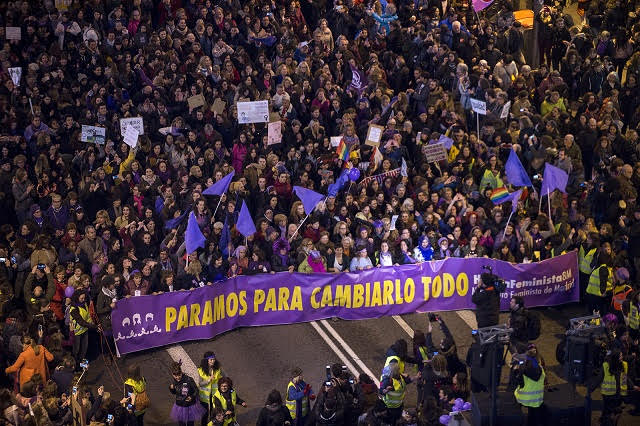
In Viewpoint magazine, philosopher and activist Cinzia Arruzza reflects on the wave of feminist activism and women’s strikes that have swept the globe in recent years, asking how these differ from earlier “waves” of feminist organizing and what potential they have for lasting agitation and change. Once novel aspect of these new struggles, argues Arruzza, is that they have resolved the tension between class and feminism that plagued Marxism in twentieth century. “These strikes,” writes Arruzza, “are feminist class struggle.” Here’s an excerpt from the text:
After more than two years of international mobilization – two International Women’s Day transnational strikes, and the recent expansion of the movement to Chile, where last summer a wave of occupations and strikes against harassment and sexual violence hit schools and universities throughout the country, as well as to Brazil, where the hashtag #EleNao, launched by some female celebrities in response to the electoral ascent of Jair Bolsonaro, triggered a process of feminist mobilization resulting in a series of mass demonstrations – it is clearly time to say that we are in the middle of a new feminist wave. A wave that has different political and geographical articulations within it, but that as a whole has posed issues such as gender violence, wage inequality, reproductive rights, and women’s reproductive work, as well as sexual liberties, at the center of the political and cultural debate of every country hit by the mobilizations. To fully grasp the impact of this event, however, it is better to clarify the terms. The current one is not the fourth or even the fifth feminist wave. It is the third and arrives around 40 years after the end of the second. In the past few decades there has been a certain tendency to label as “feminist wave” movements of thought that took place especially within campuses and their surroundings. These currents of thought have marked important turning points within feminist theory; however, they were not rooted in processes of mass social and political mobilization comparable to the feminist movement of the Sixties and Seventies. So, if with “wave” we intend to indicate a process of social and political subjectivation that takes place through mass insurgency, the term is ill-suited to indicate currents of thought or turns within a theoretical debate. Moreover, the turns within feminist thought which have been labeled as “waves” refer mostly to the periodization of the Anglo-American feminist debate; by applying the category of “wave” to them, we end up thus universalizing a geographical particularity, which instead should be “re-provincialized.”
This, of course, does not mean that the evolution of the theoretical debate of previous years has had no influence on the movement’s reflections and slogans. On the contrary, the transfeminism and the anti-essentialism of the movement are certainly indebted to queer and trans theory, and its internationalism and anti-racism are strongly influenced by work on intersectionality and on the relationship between capitalism and racialization. However, the notion of a proliferation of “waves” suggests a historical continuüm of feminist mobilizations from the second wave to the present, obscuring the nature of the current feminist movement as an event – and thus its potentialities for political and social disruption.
Image via Viewpoint.